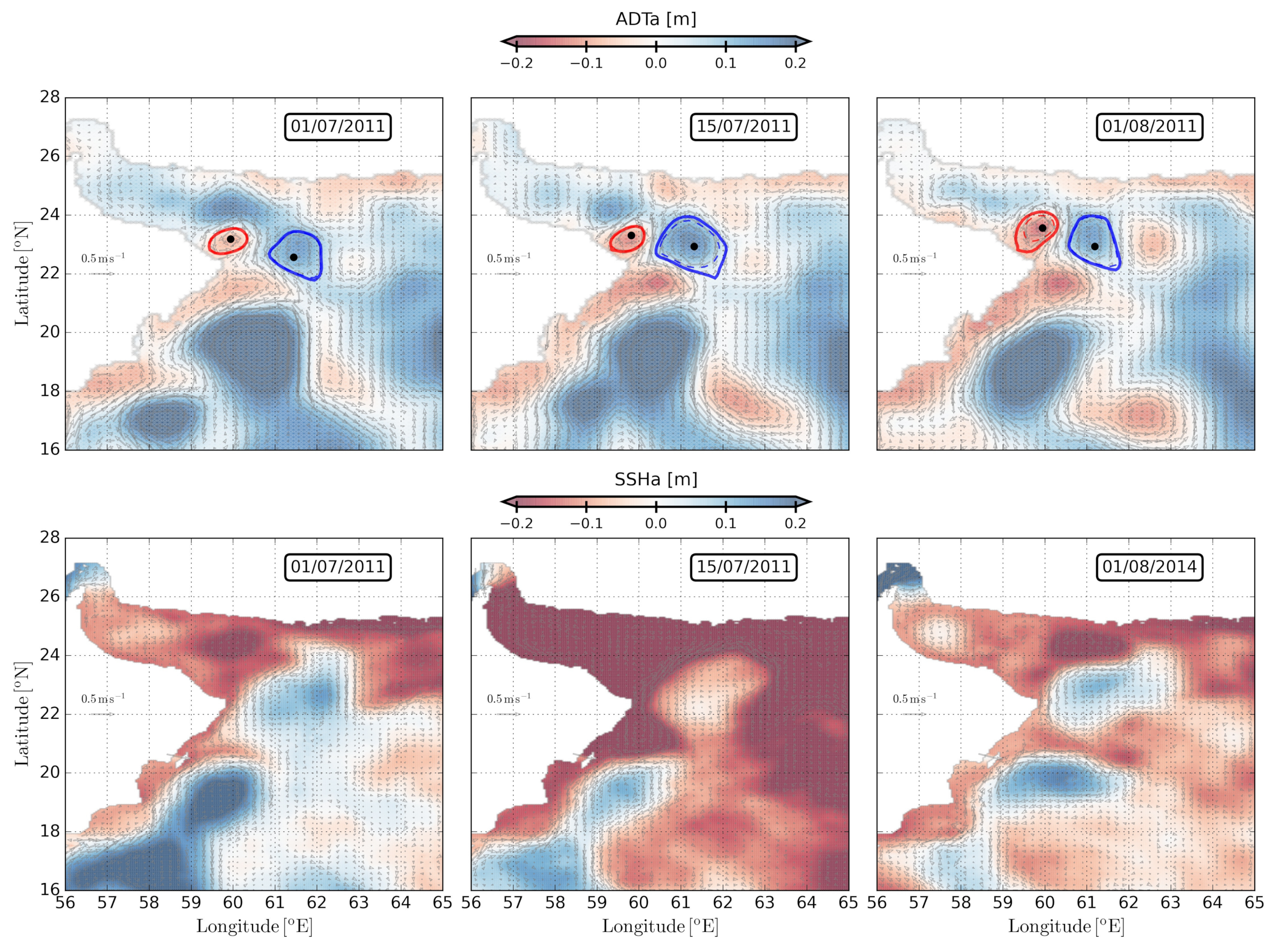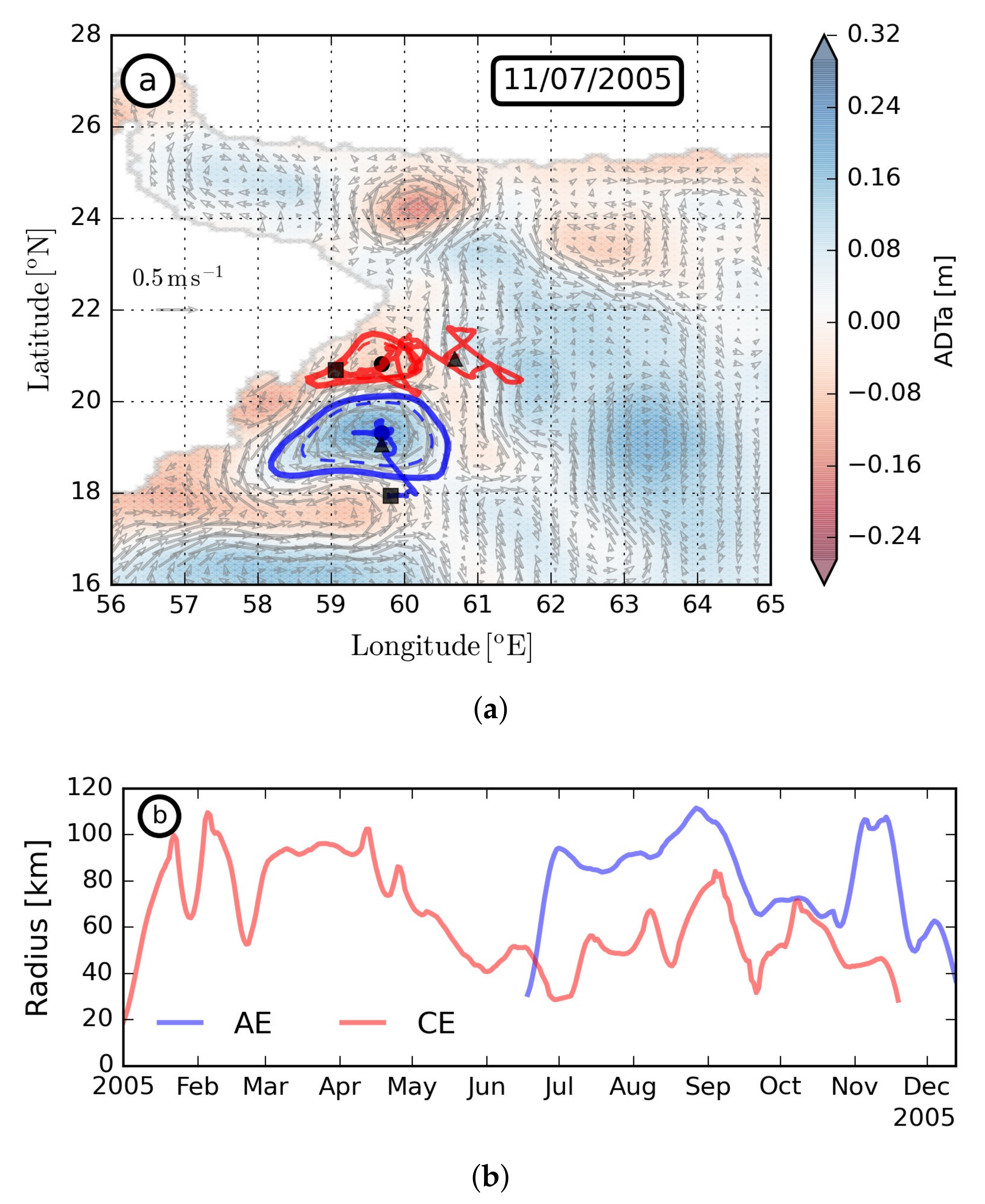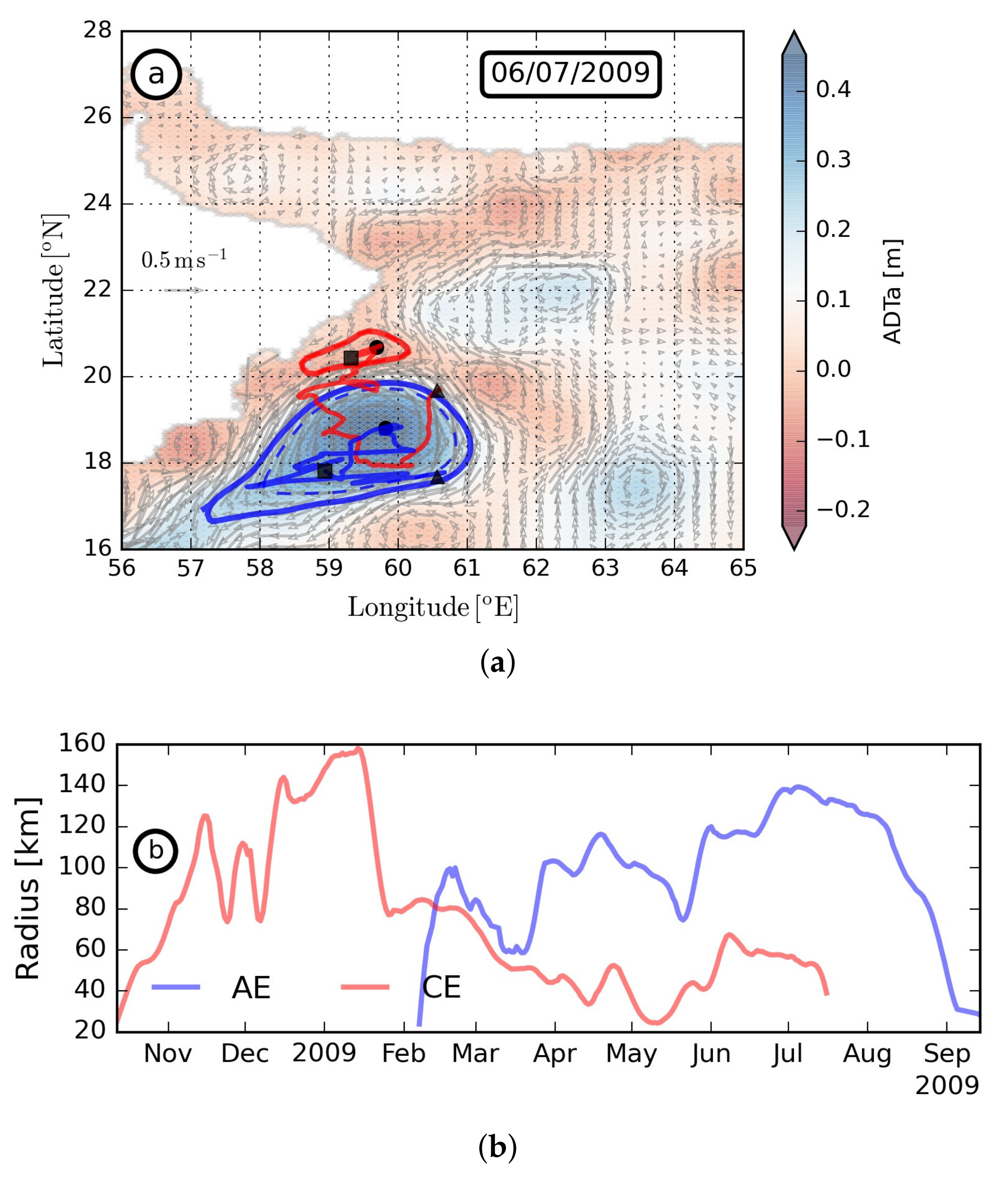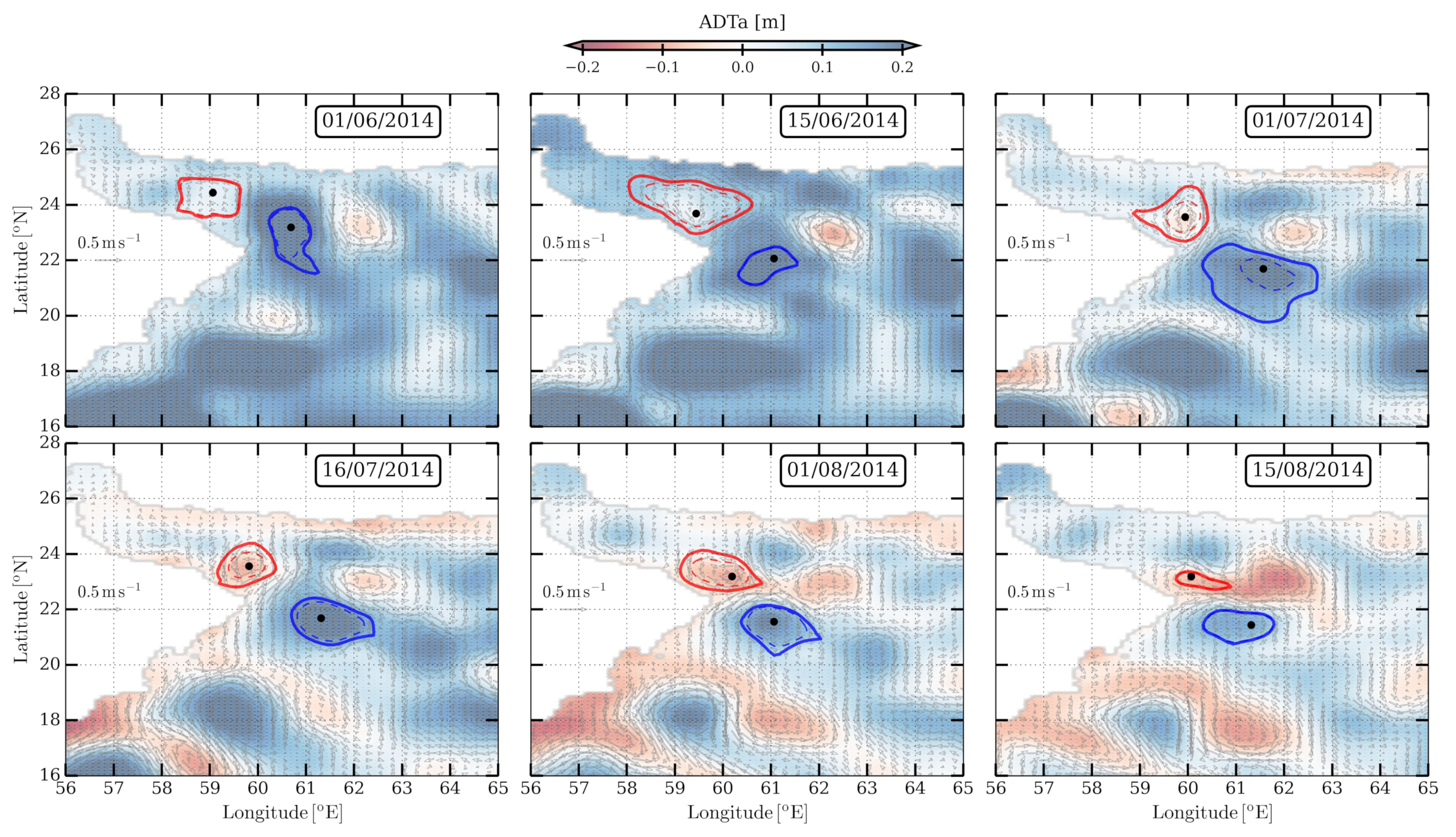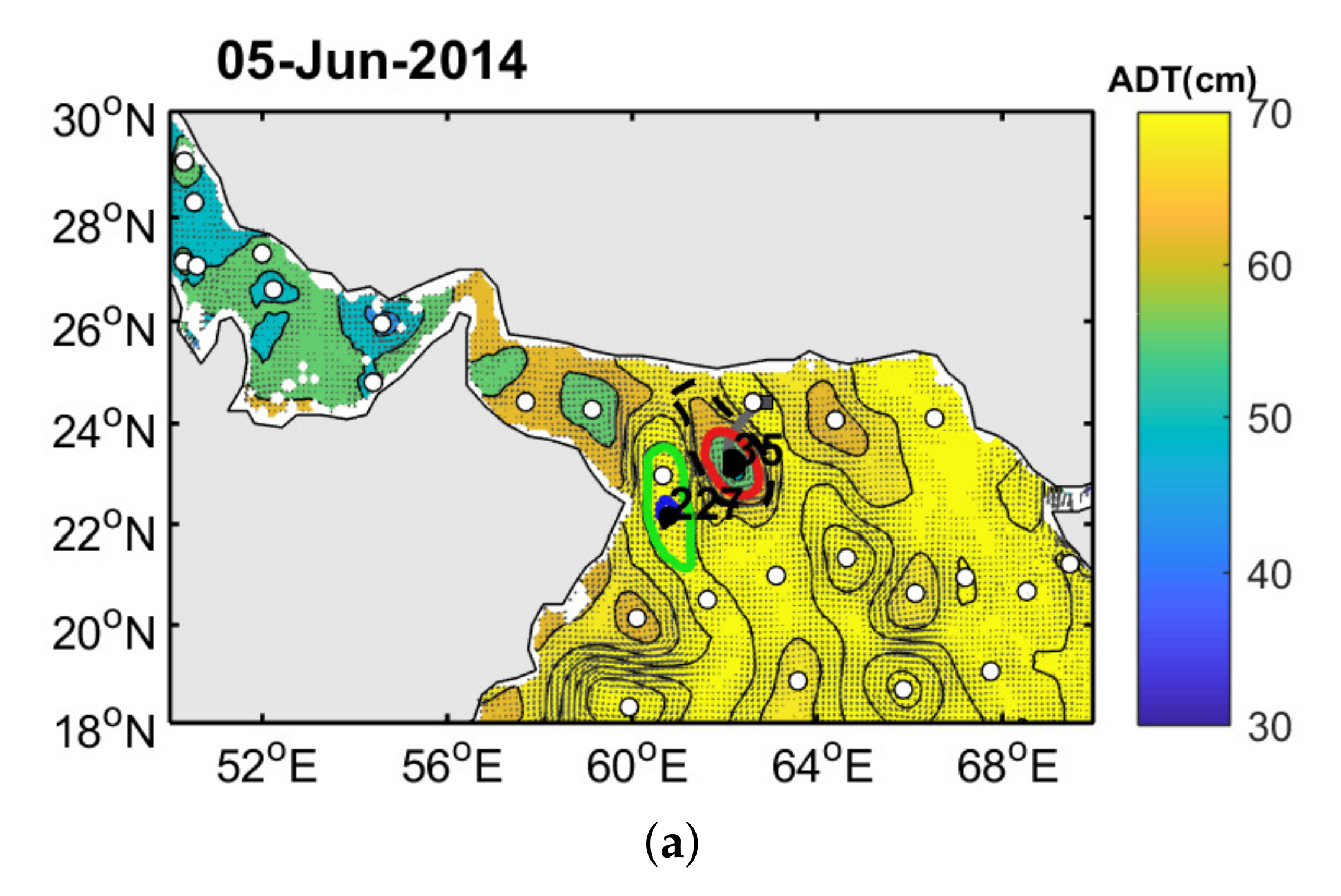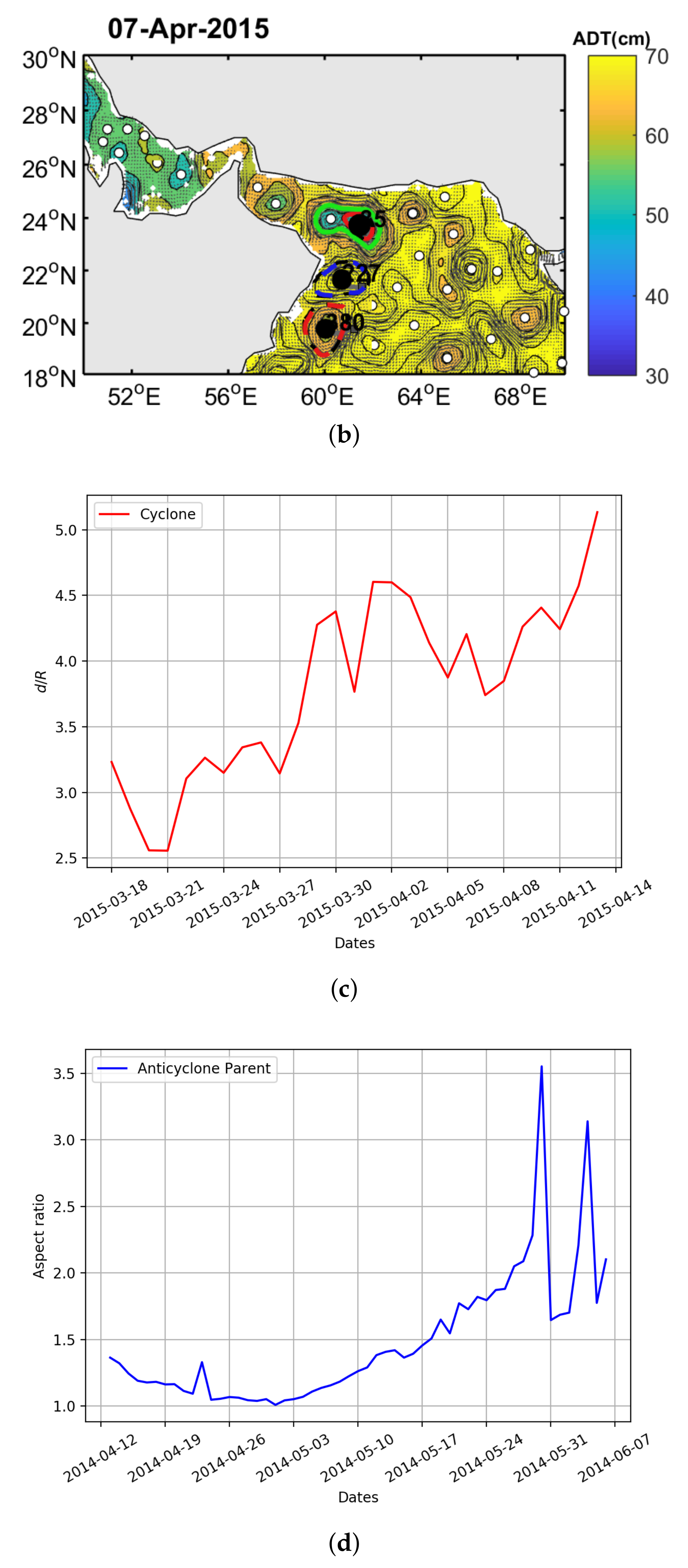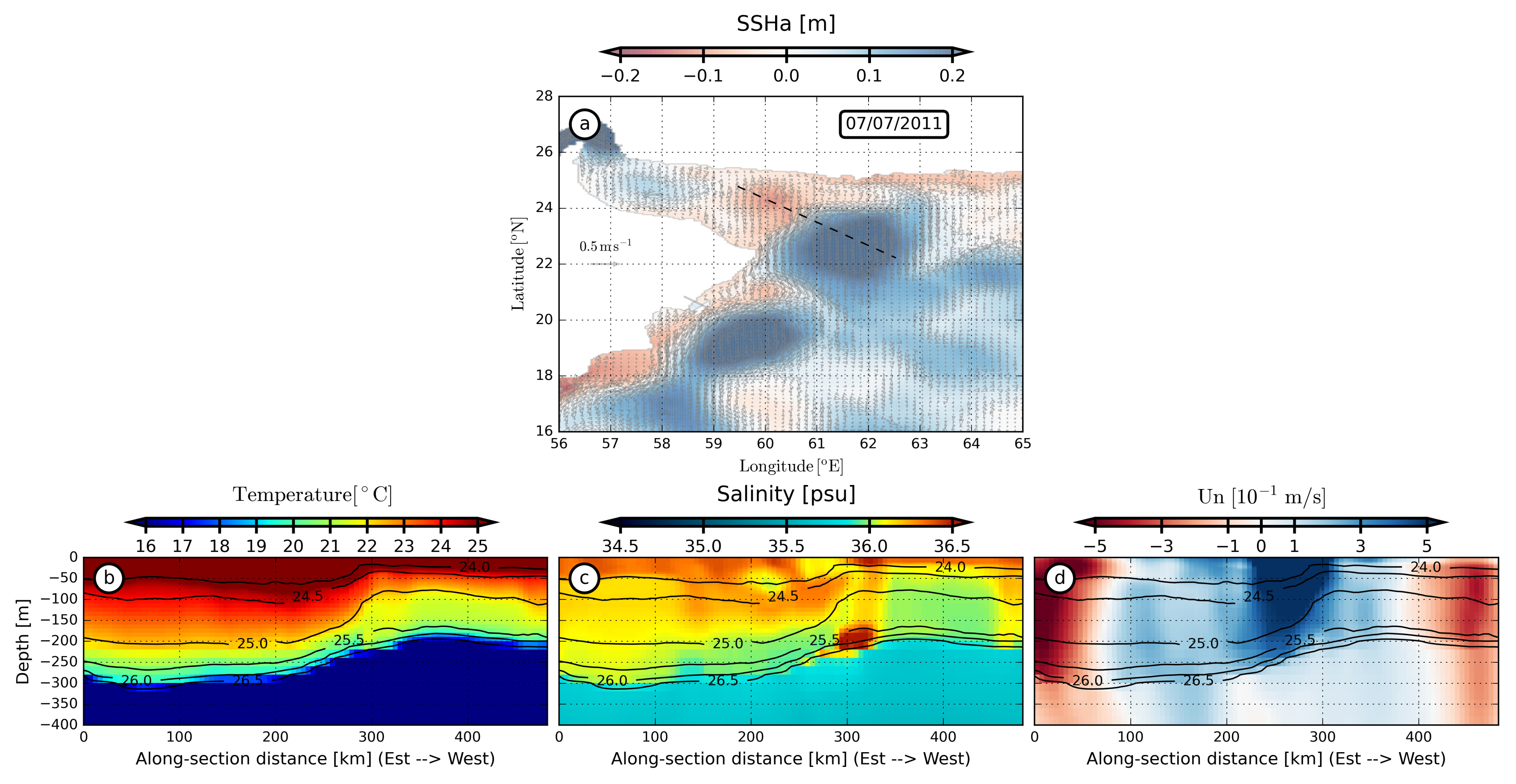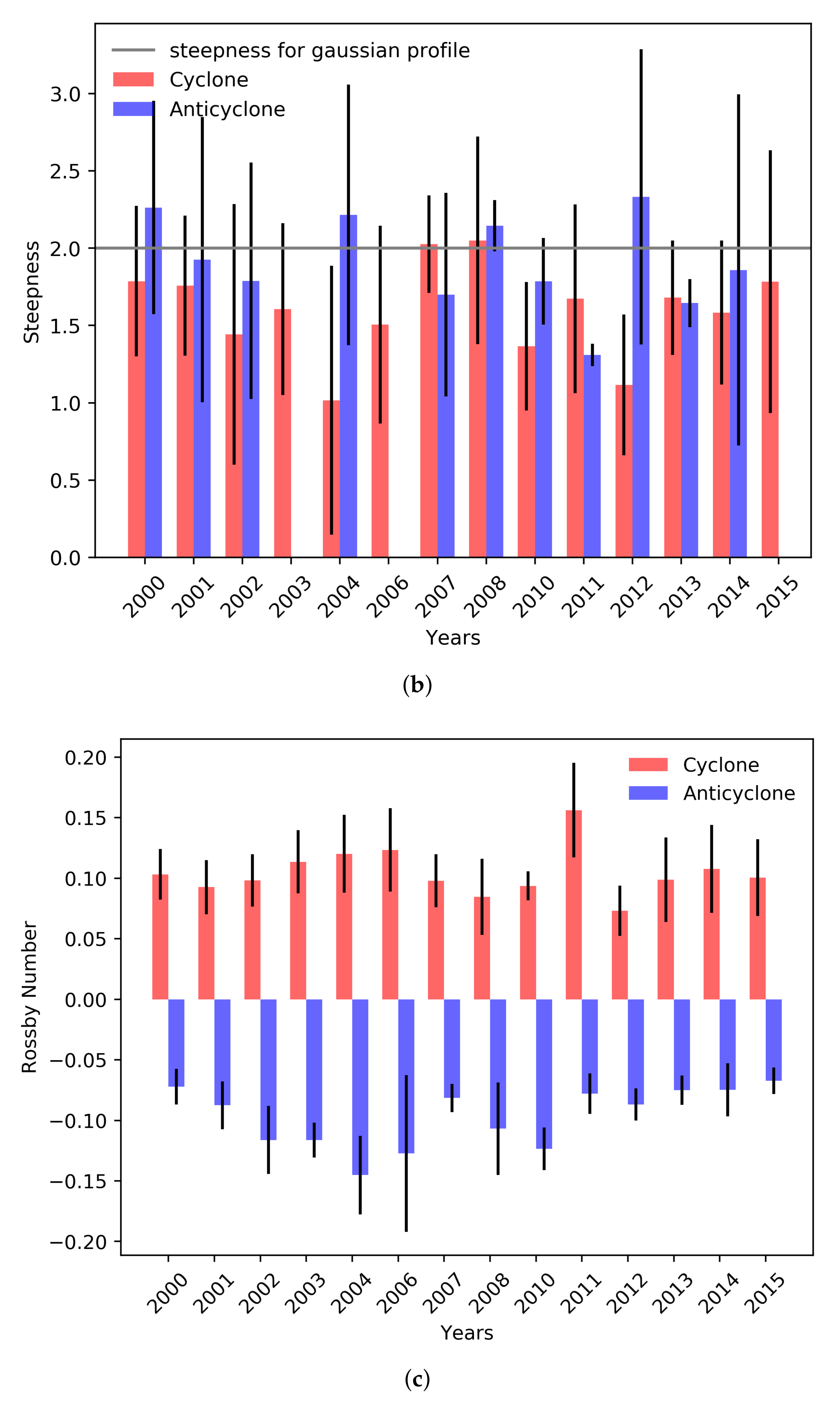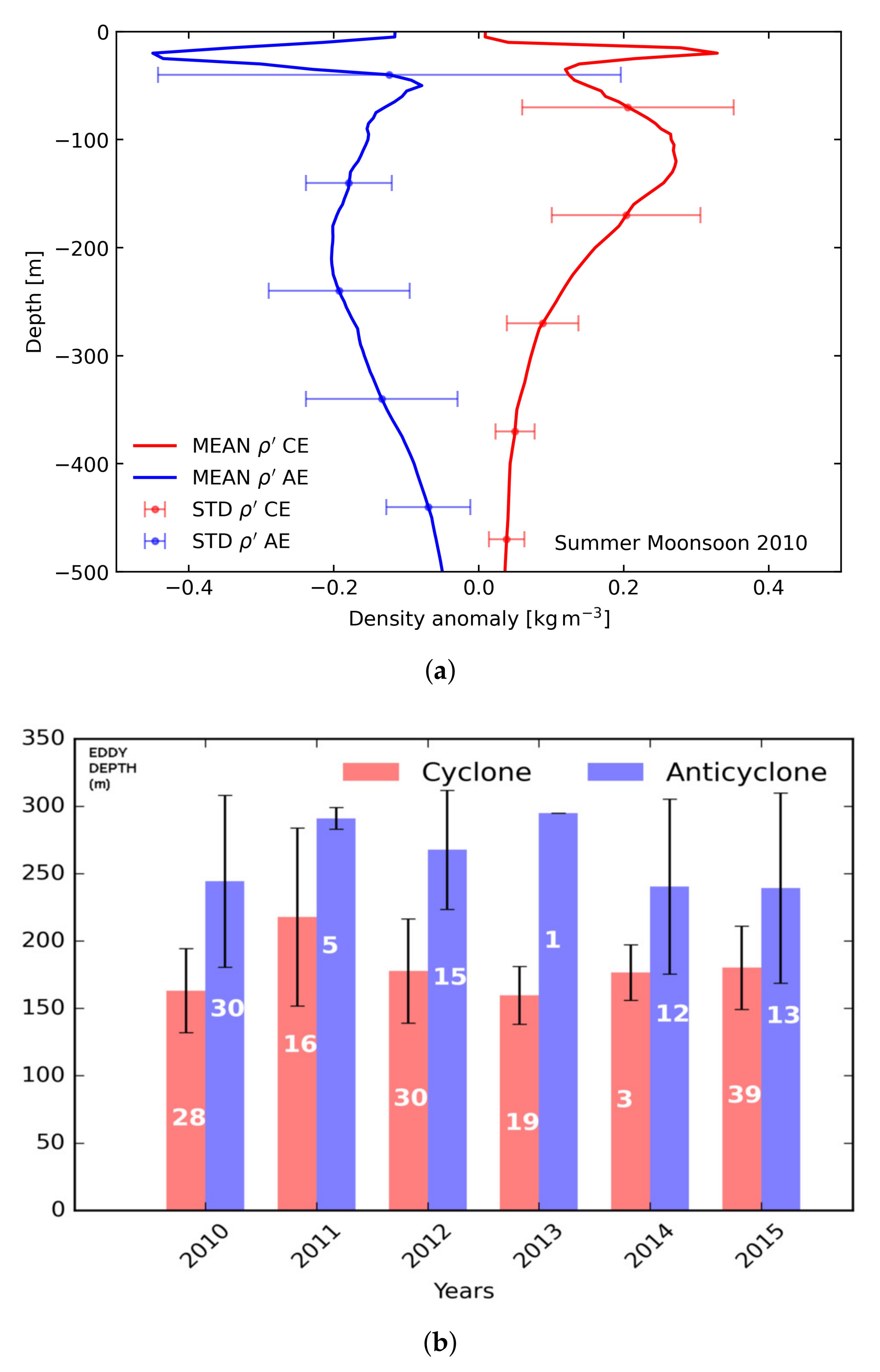1. Introduction
Over the last three decades, there has been growing interest in the Arabian Sea and in its marginal gulfs and seas, for geopolitical, economic, and scientific reasons. These seas form a complex region in terms of oceanographic variability as they are influenced by the North Equatorial Current and by the Southwest Monsoon Current. The monsoon winds, blowing over this region, are highly variable with the seasons, coming strong and northeastward from May to September, weaker and southwestward from December to February, and quite weak and variable in direction during the two intermonsoon periods (March–April and October–November). These winds drive coastal and regional ocean currents, upwellings, and downwellings near the coast. These winds also play a major role in the vertical mixing of the upper ocean water masses [
1,
2]. The alongshore currents are therefore seasonally variable too. During the summer (southwest) monsoon, the Oman Coastal Current (OCC) flows northeastward, southeast of the Arabian Peninsula, and the West India Coastal Current (WICC) flows southward. In winter, the WICC flows northward (see
Figure 1a).
Satellite observations and high resolution, primitive equation model simulations reveal that a strong turbulent activity takes place near the ocean surface in the Arabian Sea and in its marginal gulfs. The mesoscale (the mesoscale in the ocean characterizes motions of horizontal size from 10 to 250 km and time scales of 2 to 30 days) surface eddies (eddies are oceanic vortices) can be generated by the instability of alongshore currents [
3,
4] and are influenced by the wind stress curl and by Rossby waves [
5,
6]. These Rossby waves are generated at the western coast of India [
7] and propagate westward towards the south Arabian or Somali coasts. There, they can break and intensify pre-existing eddies. Since both these Rossby waves, and the coastal currents, are surface intensified, the eddies thus formed are also concentrated near the ocean surface. Some of these eddies have already been studied, some of them have received less attention.
Among the most often studied eddies in the region is the Great Whirl, a large surface eddy near the coast of Somalia. It is generated, and its intensity is modulated, by the summer monsoon wind stress curl, and by the incoming Rossby waves [
8,
9,
10]. In the central Arabian Sea, Fisher et al. [
11] observed several surface eddies via a moored currentmeter array. These eddies were generated during the summer monsoon wind stress. In the Gulf of Aden, the formation of eddies and their westward propagation are often due to wind stress during the summer monsoon [
12] but current instabilities play an essential role in eddy dynamics during the fall intermonsoon and Rossby waves play a role during the winter monsoon. In November, eddies in the eastern Gulf of Aden are formed by a northward inflow of the Somali Current through the Socotra Passage [
13]. In the Gulf of Aden, Bower and Furey [
14] discovered two eddies, the Summer Eddy and the Lee Eddy, formed by the splitting of the Gulf of Aden Eddy at the end of the Spring intermonsoon. The Summer Eddy propagates westward into the Gulf of Aden, while the Lee Eddy remains fairly stationary north of Socotra Island and these two eddies are influenced by the wind stress curl.
The importance of these mesoscale eddies lies both in their interaction with the regional dynamics, or with the atmosphere, and in their effect on the marginal sea outflows. Indeed, the Red Sea and the Persian Gulf produce salty waters which are exported into the Arabian Sea via the straits of Bab el Mandeb and of Hormuz. These two water masses are the RSOW (Red Sea Outflow Water) also called RSW (Red Sea Water) and the PGW (Persian Gulf Water). After exiting the marginal seas, the RSW and PGW outflows mix with the surrounding water masses in the Gulf of Aden and in the Gulf of Oman, respectively, then, the RSW plume stabilizes at 600–1000 m and the PGW plume at a 250–350 m depth [
15,
16,
17]. Due to the influence of mesoscale eddies or bottom topography [
4,
18,
19,
20], the PGW or RSW outflows are destabilized and they often shed smaller-scale eddies (of radii ranging between 5 and 20 km). These eddies, formed at a depth near the coast, drift away into the open ocean, carrying their warm and salty waters (see [
3,
21,
22] for the small RSW eddies, and [
23,
24,
25] for the PGW eddies). These small eddies contribute to the regional budgets of heat, salt, and momentum.
A less studied surface mesoscale eddy, or more precisely a pair of eddies, is the Ras al Hadd oceanic dipole. This association of a cyclone and of an anticyclone, exists from May to October, near Ras al Hadd, the southeastern-most cape of the Arabian Peninsula (see
Figure 1b). An intense offshore jet, the Ras al Hadd jet, lies between the two eddies. It was studied by Böhm et al. [
26] using high resolution radiometric data and Acoustic Doppler Current Profiler observations. Though Böhm et al. mentionned the presence of the two eddies near the jet, and noted their size of about 150 km, they mostly concentrated on the jet which advects cold water offshore during the summer monsoon. Indeed, this dipole marks the eastern edge of the Oman upwelling system which contains cold water. Apart from the study by Böhm et al., the Ras al Hadd dipole has not been studied in detail. Taking advantage of a new, high-resolution altimetric dataset, analyzed via vortex identification and tracking software (AMEDA: Angular Momentum Eddy Detection and tracking Algorithm), of ARGO profiling float data in the region (from the ARGO program), of a regional primitive equation model (HYCOM), the structure and the evolution of the Ras al Hadd dipole are examined here.
This paper is organized as follows: First, we present satellite and profiling float data, the AMEDA algorithm, and the HYCOM model simulations (
Section 2). Then we analyze the Ras al Hadd dipole by studying its life cycle over a year (April 2014 to April 2015), and its horizontal and vertical structures using the altimetric and the float data, and the model results (
Section 3), evaluating its inter-annual variability over a 15 year period. These results are discussed to present the impact of this dipole on its environment (
Section 4). Finally, conclusions are drawn.
2. Materials and Methods
Time series of sea surface height data were obtained via a combination of up-to-date measurements by altimetric satellites (Topex/Poseidon, ERS-2, GFO, Jason-1, Envisat, Jason-2, Cryosat-2, Altika et HY2A). Using all available missions, an ADT (Absolute Dynamic Topography) product for the Arabian Sea was processed by CLS-Argos on a
Mercator grid, with time intervals of 24 h, for the 2000–2015 period. Those products were processed by SSALTO/DUACS and distributed by AVISO+,
https://www.aviso.altimetry.fr (accessed on 1 December 2020)) with support from CNES, Centre National d’Etudes Spatiales, Toulouse, France The geostrophic velocity fields were then derived from absolute dynamic topography. The MDT used to calculate the ADT from SLA is described on the AVISO/CNES website
https://www.aviso.altimetry.fr/en/data/products/auxiliary-products/mdt/mdt-description.html (accessed on 1 December 2020) and results from an average of sea surface height above the geoid over the 1993–2012 period. It takes into account the last geoid model GOCO05S (based on the complete GOCE mission and on 10.5 years of the GRACE mission) and 25 years of altimetric and in situ data (hydrological profiles, drifting buoys). The spatial resolution of this disseminated regional data set resolves the internal deformation radius,
50–60 km, in the Arabian Sea. The spatio-temporal interpolation performed on the multiple altimetric tracks in order to build gridded products provides this
resolution while the signal resolution of altimetry is about 100 km [
27,
28]. The sensitivity test performed on the AMEDA algorithm [
29] shows that only eddies with a characteristic radius larger than 25 km could correctly be detected with the regional AVISO/CMEMS data set. In addition, a recent work [
30] compared eddies identified in a
resolution model with those found in the
AVISO product used here and concluded that eddies with radii smaller than 25 km could not reliably be detected. The Ras al Hadd dipole eddies have radii larger than 45 km. Thus these two eddies can be detected with confidence in this AVISO/CMEMS product.
To relate vortex generation or intensification with the wind stress curl, the ECMWF (European Center of Medium-range Weather Forecast) meteorological model re-analyses (ERA-Interim) were used [
31]. These re-analyses provided the regional wind every 6 h, with a
resolution.
To support our analysis of the Ras al Hadd dipole, we also used HYCOM (Hybrid Coordinate Ocean Model) model simulations. These model simulations were performed by SHOM (Service Hydrographique and Oceanographique de la Marine, France). The model has a 5 km horizontal resolution, 40 vertical levels (the upper ones being sigma levels—or terrain following levels, and the lower ones, isopycnic levels—that is, isodensity levels). The atmospheric forcing for the ocean model was extracted from the Meteo-France atmospheric model results over the region with a
horizontal resolution and a 6 h period for the year 2011. This year was chosen as typical of the meteorological variability in this region. The HYCOM model was initialized using a situation obtained from a global, lower resolution ocean model (MERCATOR PSY3, with
resolution). The results of MERCATOR PSY3 were also used for the external boundary conditions of HYCOM (temperature, salinity, and currents). The geographical domain of the HYCOM model covers the Arabian Sea, the gulfs of Oman and of Aden, the Red Sea, and the Persian Gulf, north of
S, and west of
E. The tidal forcing of HYCOM was provided by TOPEX and was included in the model at the open boundaries. Vertical mixing was parameterized with the KPP (K-profile parameterization) scheme [
32]. This numerical model has been described and validated in [
18].
To identify vortices, and in particular the Ras al Hadd dipole, in the altimetric data, we used the AMEDA algorithm. The AMEDA (Angular Momentum Eddy Detection and tracking Algorithm) method is an algorithm that detects and tracks oceanic vortices in the horizontal (geostrophic) velocity fields derived from satellite measurements of the sea surface [
29]. The AMEDA method is available and decribed on the website of the DYNED ATLAS project
https://www.lmd.polytechnique.fr/dyned/methods (accessed on 1 December 2020) with its strengths and weaknesses, and in particular, a comparison of the geostrophic and cyclogeostrophic velocities. This comparison is also performed in [
33]. The vortex centers are identified as extreme in local angular momentum, and each vortex boundary is determined via the connexity of the vortices thus found (the boundary must be a closed streamline). Tracking vortices in time relies on the spatial closeness and on the shape similarity between two vortices successively identified in time. Nevertheless, short gaps in the time series are allowed provided that the temporal continuity can be ensured (the distance between two successive positions of a given vortex must not exceed a threshold). The model also identifies merging (connection) and splitting of vortices, via the connection or separation of contours. This algorithm contains a minimal number of tunable parameters. It has been successfully tested on AVISO altimetry datasets, on ROMS model output, and on velocity fields issued from laboratory experiments. Here the AMEDA algorithm was applied to the high resolution altimetric maps.
Finally, ARGO profiling float data were extracted from the Coriolis database with only validated data with a high quality index that corresponded to the period of study, used. The ARGO profilers are deep reaching oceanic floats, equipped with temperature, conductivity (salinity) and possibly oxygen concentration sensors. These floats first dive to a given depth (the parking depth, usually between 500 and 1000 m), then they drift at this depth under the influence of the oceanic currents, for a prescribed duration (their cycle period, usually 5 or 10 days). Once every cycle, the ARGO floats move up to the sea surface, thus performing a vertical profile of temperature, salinity, and sometimes oxygen concentration, of the ocean. At the surface, the floats are positioned via GPS and they transmit their data back to the scientific institutes, via a satellite link. Then, they dive back to their parking depth for a new cycle. Therefore the vertical profile data are positioned but the exact trajectory of the ARGO floats at depth is unknown. The ARGO data used here (temperature and salinity only) were collected by floats with cycling periods of 5 or 10 days, and a parking depth of 1000 m. The Ras al Hadd AMEDA outputs for the studied period with their respective Argo profiles given in
https://github.com/aayouche/RASALHADD (accessed on 1 December 2020).
4. Discussion
The Ras al Hadd dipole is a recurrent feature composed of two eddies (a cyclone to the northeast and an anticyclone to the southwest) near the southeasternmost cape of the Arabian Peninsula, Ras al Hadd. It appears in the summer monsoon and breaks up in winter. Its position (at the cape or west of the cape) can vary from year to year. Its radius and azimuthal velocity also vary from year to year. We have found that, seasonally, the local wind stress curl intensifies the cyclone and weakens the anticyclone. It is likely that the anticyclone is strengthened both by the circulation at the upwelling front and by an upwelling Rossby wave (like the Great Whirl); a formal proof of this should be searched in forthcoming studies. Interannually, a correlation of the dipole intensity with the regionally averaged wind stress has not been evidenced. However, as Piontkovski et al. [
35] indicate, the wind stress is spatially heterogeneous so that a regional average may not represent the local effect. The recurrence of this eddy dipole is also related to the Ras al Hadd front which separates the warm waters of the Gulf of Oman, from the colder water of the upwelling south of Oman. By inspecting the dipole life cycle, it was shown that each eddy evolved via strong interactions with neighboring eddies. The two eddies are fairly wide (100 km) and their Rossby number is small, so that the cyclostrophic correction to geostrophy is small. The radial profile (the velocity steepness profile) also evolves in time with the eddy interactions. It becomes steeper as the eddy periphery is eroded under the influence of neighboring eddies. It becomes smoother as the eddy undergoes few or no interaction and as dissipation slowly acts. On average over the years, the anticyclone is slightly steeper than the cyclone. In most cases, the two eddy velocity profiles are close to Gaussian (with a steepness in the range [2.25, 2.4]). The Burger Number of each eddy (
) is of order unity, and the Rossby number is small, which shows that quasi-geostrophic dynamics should apply to model the evolution of these eddies, which are stable [
34].
An order of magnitude of the kinetic energy and heat content stored in this dipole can be obtained. Assuming that the azimuthal velocity also decays vertically as a Gaussian, we obtain, from our eddy model, and with the maximal velocities observed, a kinetic energy on the order of:
with
. For each eddy, this leads to:
Taking = 1025 kg/m, R = 5 × 10 m, H = 250 m, and = 1.15 m/s, we have J for each eddy.
Via geostrophy and hydrostatics and assuming a vertical dependence of the azimuthal velocity as
, we obtain:
where
is the density anomaly. Such a vertical dependence can indeed fit the vertical variation of the density anomaly shown in
Figure 9a. Via a linear equation of state for the upper ocean, assuming that temperature variations follow density variations, we have:
where
is the temperature anomaly associated with each eddy, and
C its maximum. The total heat (anomaly) content of each eddy is therefore:
or
where
is the eddy mass and
C is the heat capacity of seawater. This yields
J for each eddy.
Both values of eddy kinetic energy and of heat content are one order of magnitude smaller than those of the Gulf Stream rings. However the lifetime of the Ras al Hadd dipole (about 6 months) renders its contribution to the regional budgets of eddy kinetic energy and heat non negligible. Its heat fluxes towards the atmosphere should be evaluated in further work.
Furthermore, the Ras al Hadd eddies have a dynamical influence on deeper water masses, though the azimuthal velocity of these eddies is intensified in the upper 250 m of the water column. This surface intensification is due to at least two mechanisms: The stronger energy of the wind forced ocean above the thermocline, and the presence of a heterogeneous water mass at depth (PGW), which creates a strong pycnocline, attenuating the vertical penetration of the energy. The values of the azimuthal velocity for both eddies found in the present study are comparable with those measured at sea (with ADCP’s) by [
26]. The anticyclone spins slightly faster than the cyclone below a 250 m depth. However both eddies have a noticeable velocity at depth (about 0.25–0.3 m/s), which can influence the subsurface path of the PGW outflow in the region [
25]. As noted by [
25] and by [
1], the strong surface-intensified eddies of the Gulf of Oman and of the Arabian Sea pull PGW fragments away from the coast. This has been modeled hydrodynamically by [
19,
20]. The surface eddies distort the alongshore outflow and also creates an unstable boundary layer vorticity sheet, which detaches offshore and breaks into subsurface submesoscale eddies containing PGW. These small eddies play a role in the transport of heat and salt from the Gulf of Oman to the Arabian Sea.
5. Conclusions
The objective of this paper was the description of the seasonal life cycle and of the inter-annual variability of the two eddies composing the Ras al Hadd oceanic dipole. Using altimetric data and eddy identification and tracking software (AMEDA), we were able to determine the characteristics of the two eddies composing it, for a year (2014–2015). We determined their origin and drift from their initial position to their final junction near Ras al Hadd. We showed the importance of eddy-eddy interactions during the lifetime of the dipole. The evolution of the dipole was also driven by the local wind stress curl, by the upwelling circulation, and by the incoming Rossby waves.
On a longer period (about 15 years), we noted that the anticyclone was larger than the cyclone of the Ras al Hadd dipole. Though the maximal internal velocities could reach 50 cm/s, in particular for the anticyclone, the cyclostrophic correction could be neglected as the dynamical Rossby number did not exceed 0.3. This is due to the large horizontal size of the eddies. On average, the two eddies have a Gaussian radial profile of velocity, but the steepness of this profile varies with the interactions undergone by each eddy. The vertical structure of both eddies is intensified above the layer of the Persian Gulf Water but influences it dynamically.
This leads us to propose process studies to deepen our understanding of this oceanic dipole. The quasi-geostrophic approximation holds for both eddies and this could be used first to perform a stability analysis of this dipole, with respect to velocity profile steepness, to the Burger number, assuming that the cyclone and anticyclone of the RAH dipole are isolated. Secondly, the interaction of this dipole with neighboring eddies and with the Rossby waves originating from the eastern boundary of the Arabian Sea deserves a specific analysis. Finally, the dipole interaction with the atmosphere should be assessed in detail, in particular for the heat and freshwater exchanges.
